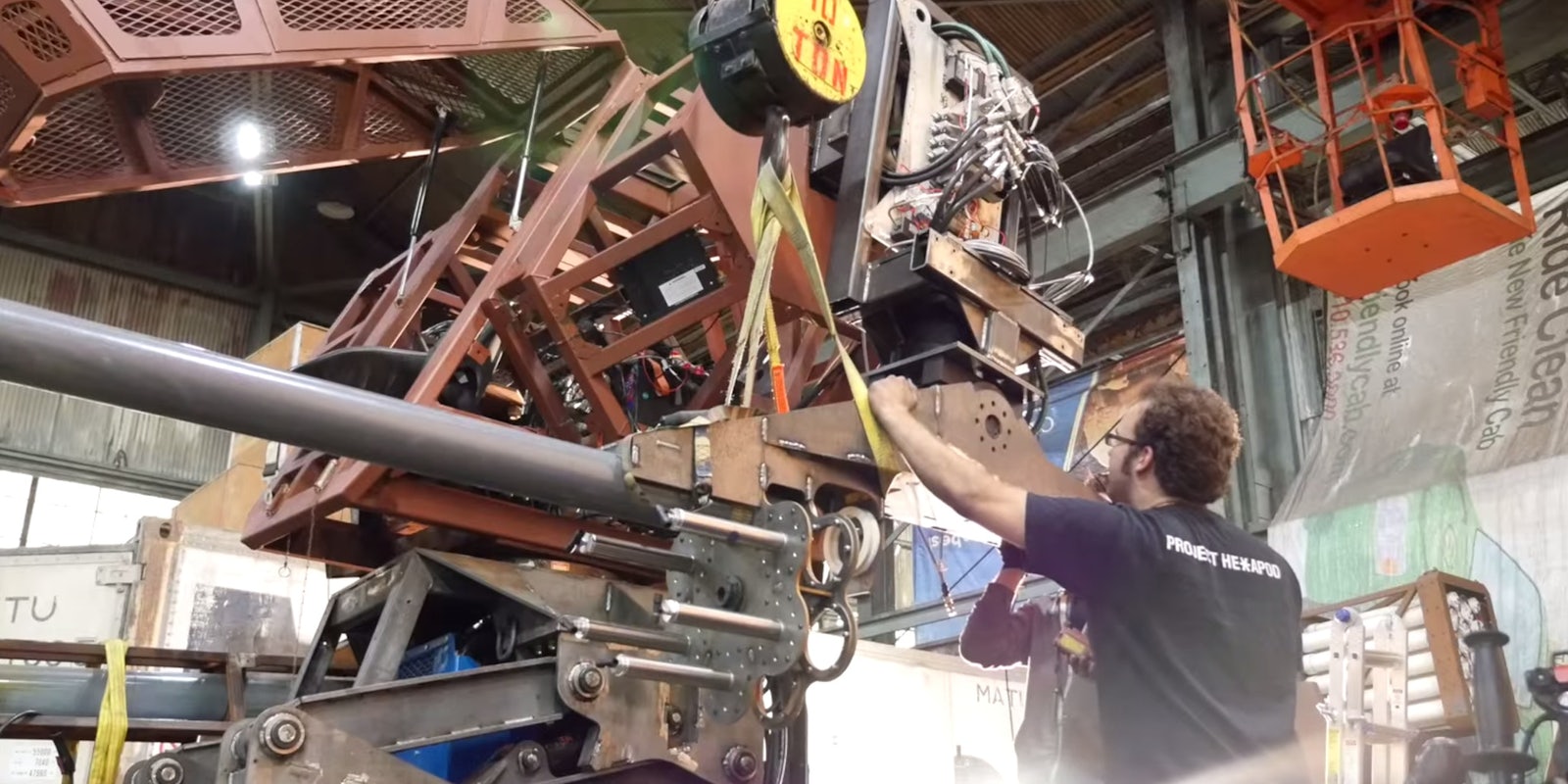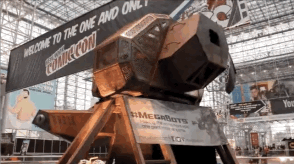The team that declared robot-war on Japan isn’t content with world domination.
MegaBots, the U.S. company that announced the international robotics challenge, has plans far grander than a one-off bout: It wants to bring robot battles to the masses as a spectator sport.
“It’s kind of like NASCAR—people can follow their favorite pilot, there’s a pit-crew, and people can learn all about the robots,” MegaBots co-founder Matt Oehrlein told the Daily Dot. “From the gear heads who want to geek out about all the tech specs, [to] the people that just want to see things blow up, and then there are people who are really into the culture of robots who love robots in general.”
Part NASCAR, part boxing, robot fighting events could pack stadiums with thousands of people, all watching monster-sized robots rip each other apart in a ring. The company is known for manufacturing 15-foot-tall mechs, which are piloted by humans much like the mecha of our teen Gundam dreams.
“All of us at MegaBots grew up with these video games, movies, and pop culture featuring giant robots,” Oehrlein said. “It’s kind of like this really goofy childhood fantasy that a lot of people identify with because it’s so ridiculously sci-fi, and it seems like something that could never really happen in our lifetime, but everyone likes to imagine themselves being one of these giant robot pilots.”
There are already a handful of robot battles and challenges. DARPA’s recent robotics challenge pitted cutting-edge machines from robotics teams around the world against each other in a public obstacle course. But MegaBots is leading the charge to make mechs big enough so that even fans in the nosebleed seats can see the action.
Mark 2 is MegaBots’ current creation. It stands almost three-times as tall as your average human woman and weighs 12,000 pounds. Its “feet” are gigantic Caterpillar skid steer tracks—those “wheels” you see on forklifts and construction loaders—and the rest of Mark 2’s body is entirely custom built. Oehrlein and the MegaBots team created Mark 2 out of laser cut welded steel, pieced together by hand with hydraulic components from construction equipment. (The only things that aren’t custom built are those skid steer feet.) Two grown adults can sit comfortably inside the body of Mark 2, where they can aim and shoot giant paint balls at up to 100 miles-per-hour.
Next, MegaBots will need to prove to the world why and how filling stadiums with thousands of pounds body-crushing metal is a good idea—and figure out how to get people to pay for it. Previously, the company failed to crowdfund its robot sporting arena plans, raising only $65,000 of a $1.8 million goal last fall.
The robot battle challenge against Suidobashi Heavy Industry’s Kuratas robot is the first step to making the whole idea go mainstream. For now, the Japanese robot and MegaBots’ Mark 2 remain the only battle-ready robot giants that could face each other in a ring. Turning robo-battles into a full-fledged sport would require significant investment and sponsorship—and the company doesn’t have either of those things quite yet.
After MegaBots’ first failed attempt to raise money for its project, AutoDesk—a software company known for incubating viral technologies—reached out to offer its support, sponsoring the creation of the very first fighting robot in the U.S. With AutoDesk’s investment, MegaBots grew from a nostalgic pipe dream to a grown-up, fully-realized robot factory.
While raising money and corporate sponsorships might prove to be challenging, Oehrlein remains optimistic that people from all walks of life will be willing to pay to watch giant robots fight to the death. The audience already exists—it just requires some advertising.
Despite what the goofy, absurdly patriotic, explosion-centric challenge video might convey, Oehrlein and his technical co-founder Gui Cavalcanti are well-qualified to take robot battles to the masses. The pair met while each were working in maker spaces in different parts of the U.S., and decided to work together on the ambitious engineering project.
Oehrlein spent most of his engineering life at a research and development lab at the Eaton Corporation, where he worked on building control systems for big early-stage construction equipment and hydraulic tech for the military. Cavalcanti spent years at Boston Dynamics, engineering the hydraulic and electric robots of our nightmares, including the infamously rugged walking military contraption known as Big Dog.
Given that the robot battle isn’t taking place for another year, the hype surrounding MegaBots’ throwdown challenge could ramp up mainstream momentum or just fizzle out. While a year gives other potential participants time to create their own giant Gundam-like mech robots and MegaBots time to iterate on its own idea—likely creating Mark 3, a bigger, better robot to take on Kuratas—the delay also risks losing the viral interest that it’s generated.
Still, the timeline is well suited to MegaBots’ ultimate goal of massive mainstream appreciation of robo-sports. “That gives us time to prepare the logistics of the battle, nail down the rules, like ‘Can robots shoot? Punch each other?’” Oehrlein said. “It gives us a chance to work out the details of the fight and secure media partners.”
Though it may seem straight out of fantasy action films, turning robot fighting into a spectator sport isn’t a completely far-fetched idea. Only a few short years ago, the burgeoning market for spectator gaming was something most people dismissed outright. Now, esports is a multibillion dollar industry with competitions around the world, celebrity champions, and millions of dollars in prizes. Could robo-battles be the next great geek sport franchise?
In the meantime, Oehrlein and his team are taking Mark 2 on tours around the U.S., drumming up support for battle bots and the dream of making fighting robots as mainstream as pay-per-view MMA fights. This week you can find him at San Diego Comicon, showing off the 15-foot giant that started it all.
Photo via MegaBots Inc/YouTube



